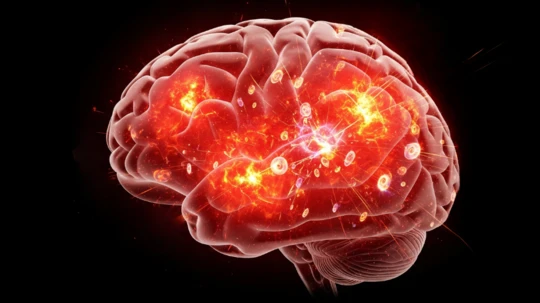When 48-year-old Ryan Alto from California walked into the emergency room with what seemed like mild flu symptoms, no one-not even he-could have predicted how rapidly things would spiral.
Within hours, he was hallucinating. Soon after, he lost consciousness. By the end of the day, Ryan had slipped into a coma. What doctors discovered next would upend everything his family knew about illness, mental health, and recovery.
He wasn’t battling a virus. He wasn’t having a psychiatric breakdown. Ryan had Anti-NMDA Receptor Encephalitis-a rare, autoimmune brain disorder so misunderstood it’s often mistaken for mental illness.
What is Brain on Fire Disease?
Anti-NMDA Receptor Encephalitis, sometimes referred to as “Brain on Fire” disease, is caused when the body’s immune system mistakenly attacks NMDA receptors in the brain. These receptors play a key role in memory, cognition, and behavior. When they malfunction, it can look eerily similar to a psychiatric or neurological breakdown.Symptoms of Brain on Fire Disease
Initially, patients often present with flu-like symptoms: mild fever, fatigue, headaches. But in a matter of days, things can shift dramatically-paranoia, hallucinations, speech problems, seizures, and even catatonia may emerge.
In Ryan’s case, these escalated quickly. He started speaking incoherently. He experienced delusions, then seizures, and within days, fell into a coma that lasted eight weeks. When he woke up, the world was unrecognizable. He couldn’t stand, speak, or even identify familiar faces.
Anti-NMDA receptor encephalitis affects an estimated 1.5 people per million annually, but that number may be underreported due to frequent misdiagnosis. Its symptoms mimic schizophrenia, bipolar disorder, or severe anxiety, often delaying correct treatment.
Women, especially between ages 12 to 45, are disproportionately affected. In these cases, the condition is frequently associated with tumors, particularly ovarian teratomas, which trigger the immune response. For others, it can follow a herpes simplex infection-another key but underrecognized link.
A study published in Neurology found that nearly 27% of patients recovering from herpes simplex encephalitis went on to develop autoimmune encephalitis, with Anti-NMDAR accounting for the majority of those cases.Can ‘Brain on Fire Disease’ Be Treated?
The key to managing this condition lies in quick recognition and aggressive early treatment. But diagnosis isn’t straightforward. Blood and cerebrospinal fluid tests are needed to detect the anti-NMDA antibodies, which can take time-time many patients don’t have.
That’s why most experts recommend beginning immunotherapy based on clinical suspicion, even before test results are back.
Treatment typically begins with high-dose steroids, intravenous immunoglobulin (IVIG), or plasmapheresis to suppress the immune attack. If a tumor is detected, surgical removal becomes urgent. In more stubborn or recurring cases, drugs like rituximab or cyclophosphamide are introduced for long-term immune modulation.
In Ryan’s case, immunotherapy began after his coma was induced to manage seizures and brain swelling. Since regaining consciousness, his recovery has been slow but steady. He remains disoriented and confused, sometimes mistaking objects or people for things they’re not-a stuffed toy, to him, is a living creature. He’s learning to move again, a process his family says may take up to a year or more.
One of the most challenging aspects of anti-NMDA receptor encephalitis is managing its psychiatric manifestations. Patients can swing between aggression, hallucinations, mutism, and catatonia-often within hours. That’s why psychiatric support is as crucial as neurological intervention.
Medications like benzodiazepines, valproic acid, and certain antipsychotics like quetiapine are commonly used to manage behavioral symptoms. But the challenge lies in balance: too much sedation can worsen neurological symptoms like abnormal movements or cognitive delays.
Doctors typically tailor medication regimens carefully, opting for sleep aids like trazodone or clonidine when needed and tapering off psychiatric drugs as neurological recovery improves.How Treatment Helps Manage Seizures?
Seizures are common in anti-NMDA receptor encephalitis and often the first visible signs of a deeper problem. Most patients experience focal or generalized seizures, and while immunotherapy usually helps reduce them, anti-seizure medications are added to prevent complications.
Interestingly, sodium channel blockers tend to perform better than some commonly used medications like levetiracetam, which can worsen psychiatric symptoms. Most patients can eventually taper off anti-epileptics after two to three years of stability.Can This Disease Come Back?
Unfortunately, yes. Relapses are a real possibility, even years after initial recovery. This underscores the need for long-term monitoring. Experts advise follow-ups with a neuroimmunologist, especially if the original trigger-like a tumor-was never identified.
If relapse occurs, doctors recommend treating it as aggressively as the first time: re-evaluation for tumors, renewed immunotherapy, and psychiatric support.
If you or someone you know starts showing sudden, unexplained changes in behavior-especially after a recent infection or illness-don’t dismiss it. Ask about autoimmune encephalitis. Because sometimes, what looks like a breakdown… is actually the brain crying out for help.
